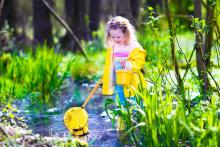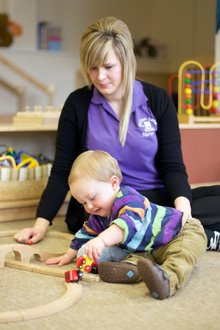This article was originally written for Under 5 magazine by Alison Heseltine, early years development manager at the Alliance.
Enjoyed by young and old alike, playdough is a fabulous resource that you can use for tactile play. Its squishy, malleable nature makes it a favourite among children, offering not just entertainment but developmental benefits too. In this blog, we'll explore the numerous advantages playdough brings to the table – from enhancing fine motor skills to encouraging creativity and expressing themselves, as well as sharing our favourite homemade playdough recipes.
Playdough supports personal, social and emotional development by helping children:
- Engage in quieter, calmer and more reflective play in a busy world where they can explore their own emotions and feelings
- Learn to share resources, starting to become aware of the needs of others and to negotiate
- Build resilience and perseverance – overcoming challenges and adjusting ideas when things don’t quite go to plan
Playdough supports communication and language by helping children:
- Learn and practise new vocabulary, especially action and description words
- Develop the language of thinking – what, why and where, bringing the ideas in their mind to life
- Build narratives – sharing their stories and explanations
- Develop social skills – learning how to communicate with others in play
Playdough supports physical development by helping children:
- Develop fine motor skills through rolling and squeezing dough, which can support later writing skills
- Develop gross motor skills and muscle strength, boosting their confidence to join in with play
- Build core strength and maintain their sense of balance
- Coordinate movement in different parts of their bodies
Playdough supports literacy by helping children:
- Support fine motor skills for later writing skills, including through mark-making in playdough using tools, other toys or hand
- Make up stories with playdough and sharing these together
- Learn to follow instructions
Playdough supports mathematics by helping children:
- Measure quantities and learn/practise mathematical language: big, small, heavy and light
- Create and name both 2D and 3D shapes together
- Build on and practise their counting skills: balls of dough or cups of flour
Playdough supports expressive arts and design by helping children:
- Express themselves: playdough can be anything or nothing at all, as the process is more important than the product
- Share their ideas and learn about symbolic thinking through playing pretend
Playdough supports understanding the world by helping children:
- Develop their thinking about how the dough changes and reacts when they play with it
- Experience different textures, colours and scents that stimulate their senses
Playdough doesn’t have to be an expensive resource – you can make it yourself! Here, we’ve included a few of our favourite recipes to share with you. These can be enhanced by adding scents and colouring that are safe to use if you wish. You can also offer tools or other resources, such as shells or pinecones, to enhance the activity.
Please be careful with aromatherapy oils as some can be skin irritants.
Cleaning tips for homemade playdough: soak tools/equipment in hot water for a few minutes to dissolve; if it gets onto the floor, it can be swept up or, once dried, vacuumed.
Playdough
This recipe needs to be made by an adult and given time to cool before it can be played with.
Ingredients
- 2 cups of flour
- 1 cup of table salt
- 2 tsp cream of tartar
- 1 tbsp vegetable or sunflower oil
- 2 cups of boiling water (adult)
- Safe to use scent or food colouring of your choice if you wish
Instructions
- In a bowl, combine the flour, salt and cream of tartar, and mix well
- Add in the oil
- If you’re using them, mix a few drops of food colouring and scent into the bowl
- Carefully add the boiling water
- Mix everything together well and, once cooled, knead with your hands until no longer sticky (add more flour as needed)
- Once it’s fully cooled, put in an airtight container and store in the fridge
Cold water and salt free playdough
This recipe is a fun way to get children involved in making their own playdough. It doesn’t last as long, but it’s safer for children to make themselves and is great for extending children’s learning and development via the process.
Ingredients
- 2 cups of plain flour
- ½ cup vegetable oil
- 1 cup cold water
- Food colouring if desired
Instructions
- In a large bowl, add oil to the flour and mix
- If you are using food colouring add this to the water first and then pour the water into the bowl with the flour and oil
- Stir well and then tip out and knead bringing the dough together into a ball
- The great thing about this recipe is that if it’s a bit too wet, add a bit more flour; if it’s too dry, add a bit more water
- Have fun and when you’ve finished playing keep it in an airtight container – but be aware it won’t keep as long
Gluten-free playdough
Sometimes we need a gluten-free playdough for our children. With this recipe, you may find you need to add more flour/conditioner until you get the dough consistency right.
Ingredients
- 1 cup hair conditioner
- 2 cups cornflour
- Food colouring, if you want to make your dough a different colour
Instructions
- Mix together the conditioner and cornflour in a bowl
- If you want to add food colouring, do this while mixing
- Keep stirring until it comes together as a lump
- Knead until smooth
- Keep in an airtight container as it doesn't keep as well







